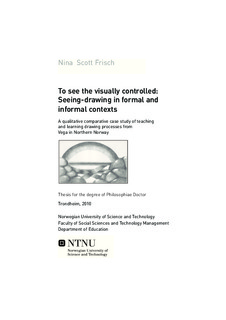| dc.contributor.author | Frisch, Nina Scott | |
| dc.date.accessioned | 2010-05-07T07:47:22Z | |
| dc.date.available | 2010-05-07T07:47:22Z | |
| dc.date.issued | 2010-05-06 | |
| dc.identifier.isbn | 978-82-471-2120-7 | |
| dc.identifier.issn | 1503-8181 | |
| dc.identifier.uri | http://hdl.handle.net/11250/145832 | |
| dc.description.abstract | The informal visually controlled drawing processes are seen as traces of wanted, voluntary
visual expressions. This aspect of informal drawing processes is stressed by all six students/
children interviewed about similarities and differences. The compulsory aspect of what
happens in the formal arena can not be disregarded, compulsory public school being bound to
the national curriculum at all times. But the learning goals in the national curriculum can be
attained in different ways, and learning goals can change as discourses in art education change.
This can possibly gives room to work within a compulsory school context and still aim for “the
flow”. The flow being where students feel they work on gaining a wanted skill and at the same
time are given challenges and help that makes these wanted skills attainable
(Csikszentmihalyi, 2002). The web database The Vega files exhibits the formal drawings made
in a case seen as exemplary visually controlled drawing teaching, with goals being within the
compulsory national curriculum in art & crafts in Norway, and can be seen as a reflection of
concepts found in the inquiry.
In my opinion, this qualitative inquiry would not be that interesting in an art education
context if the informal VC-drawing activities in this age-group were not to be quantified to a
certain extent. If informal VC drawing learning/teaching was a rare or practically nonoccurring
activity, the comparison, based on qualitative methods of inquiry, with the aim of
describing the qualities of formal and informal VC-drawing teaching/learning activities, would
not rest on one of several features of informal drawing activity. The drawing web database is
one reference for detecting the informal VC processes (see The Vega files and page 92 in
Chapter 2). What has been detected as VC processes and semi-VC-processes - resting on the
drawing database, the interviews and the observations shows that substantial informal VCdrawing
learning (but also teaching) activities are taking place.
The third research question can be the basis for the summary, rounding up this
inquiry’s main results when comparing the two previously presented cases by structuring the
comparisons using the comparative dimensions:
What are the similarities and differences between these formal and informal visually
controlled drawing processes? | en_US |
| dc.language.iso | eng | en_US |
| dc.publisher | Norges teknisk-naturvitenskapelige universitet, Fakultet for samfunnsvitenskap og teknologiledelse, Program for lærerutdanning | en_US |
| dc.relation.ispartofseries | Doktoravhandlinger ved NTNU;2010:79 | |
| dc.subject | Kunst og håndverk | en_US |
| dc.subject | fagdidaktikk | en_US |
| dc.subject | barnetegning | en_US |
| dc.title | To see the visually controlled: Seeing-drawing in formal and informal contexts: A qualitative comparative case study of teaching and learning drawing processes from Vega in Northern Norway | en_US |
| dc.type | Doctoral thesis | en_US |
| dc.subject.nsi | VDP::Social science: 200::Education: 280::Subject didactics: 283 | en_US |
